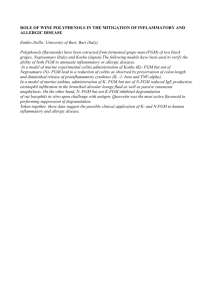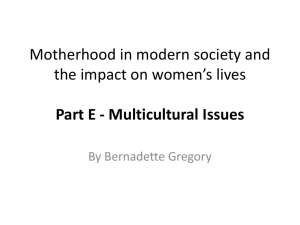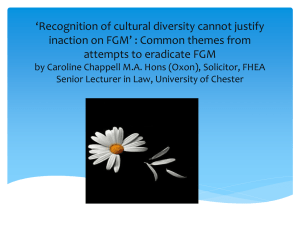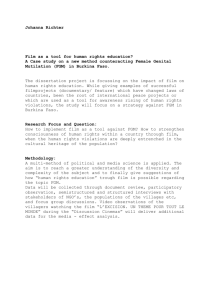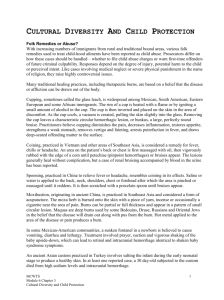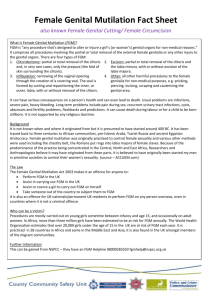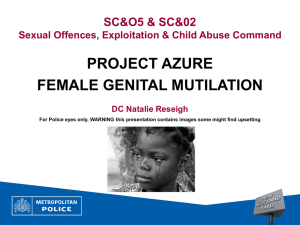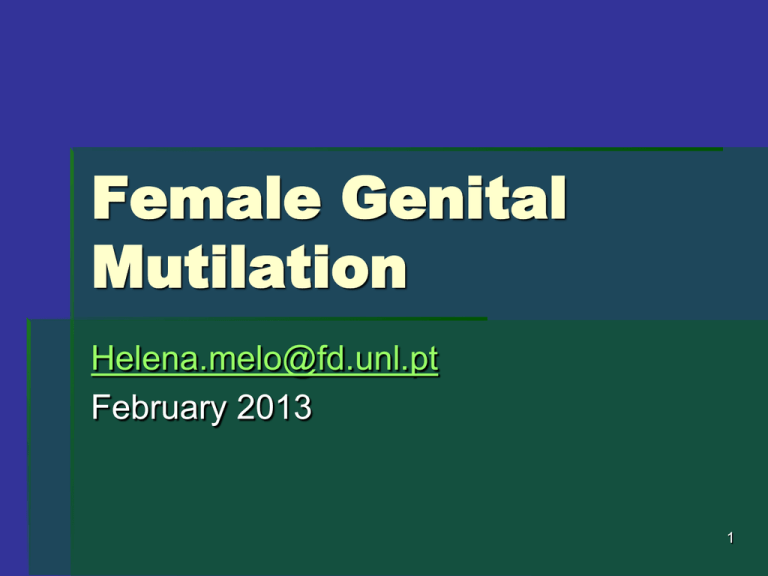
Female Genital
Mutilation
Helena.melo@fd.unl.pt
February 2013
1
Other expressions for this traditional
practice:
Female circumcision;
Female traditional surgery;
Female cutting;
Excision…
2
WHO, 2011
An estimated 100 to 140 million women
worldwide are living with the consequences
of FGM.
In Africa an estimated 92 million girls from
10 years of age and above have undergone
FGM;
An average of 4 girls each minute are
mutilated.
3
4
5
BBC, August 2010
THE NUMBER OF CASES OF FGM REPORTED
IN LONDON HAS RISEN AND SOME
PROCEDURES ARE TAKING PLACE IN THE
CITY, A DOCTOR HAS SAID.
THE METROPOLITAN POLICE SAID IT WAS
AWARE THAT FGM WAS TAKING PLACE IN
LONDON AND HAD INTERVENED IN 122
CASES SINCE 2008, INCLUDING 25 TIMES
THIS YEAR.
6
Waris means Desert Flower, a flower that can
bloom even in the roughest climate. Waris Dirie
is a nomadic child from Somalia, a human rights
activist and a supermodel.
7
Up to 500,000 girls and women living in the
European Union are affected or threatened
by
FGM.
75,000 of them live in Great Britain, 65,000
in
France,
30,000
in
Germany.
The victims are migrants, whose families
took along this practice when they
immigrated.
8
What is FGM?
9
Joint Statement WHO/UNICEF/UNFPA:
“the
partial or total removal of the
external female genitalia or other
injury to female genital organs for
cultural or other non-medical
reasons” (1997, 2008)
10
Types I, II, III:
11
Type IV:
12
Type I:
Type II:
excision of the excision of the
clitoral
hood clitoris
with
(prepuce), with or partial or total
without excision excision of the
of part or all of labia
minora.
the
clitoris.
13
Type III:
Type IV:
excision of part or all of all other procedures
the external genitalia
that involve pricking,
and
stitching/
piercing, stretching
narrowing
of
the
or incising of the
vaginal
opening.
clitoris and/or labia;
Infibulation.
introduction
of
corrosive substances
into the vagina to
narrow it.
14
Mostly practiced:
Type I – Mali, Nigeria, Burkina Faso and
Senegal;
Type II – Sudan and Burkina Faso;
Type III – Djibouti, Egypt, Gambia, Mali,
Eritea, Ethipoia, Somalia and Sudan –
15% of FGM.
15
Who does it?
16
Traditional circumcisers:
Elderly accredited women who come
from a family in which generations of
women
have
been
traditional
practitioners;
Without medical training;
Have a well paid job;
Enjoy a high social status within the
community.
17
To whom?
18
Women:
From infancy to adulthood (before
marriage);
Rite of passage to womanhood;
Children who do not consent and
do not know what will happen to
them during the procedure.
19
20
The girl is held down and immobilized by a
group of women and by the mother, with her
legs open. During the mutilation, nothing is
done to ease the pain and the wound may be
dabbed with alcohol, lemon juice, ash, cow
dung…
WHO
21
Unsterile instruments:
22
In Europe:
doctors from ethnic communities
practice FGM illegally at home or in
private hospitals;
emigrants bring their girls back
home to be circumcised in the
traditional way.
23
International Federation of
Gynecology and Obstetrics:
“oppose any attempt to medicalize the
procedure or to allow its performance,
under any circumstances, in health
establishments
or
by
health
professionals” (1994)
24
European Parliament
- resolution of 5
April 2011 on priorities and outline of a
new EU policy framework to fight
violence against women
”Urges the Member States to recognize to reject
any reference to cultural, traditional or religious
practices as a mitigating factor in cases of
violence against women, including female
genital mutilation;”
25
Consequences?
26
27
Shock, long-lasting trauma;
Physical pain;
Painful sexual intercourses;
Permanent frigidity;
Psychoses;
Loss of trust in her own family.
28
Sitting and walking became a
torture;
More complications when giving
birth to a baby;
Higher death rates among babies
during and immediately after birth;
Absence from school and work.
29
Defibulation:
To allow penetration in the first sexual
intercourse;
To deliver the baby – infibulated again
afterwards.
30
31
Reasons - WHO:
a)
b)
c)
d)
e)
Socio-cultural;
Psycho-sexual;
Hygienic and aesthetic;
Spiritual and religious;
Economic.
32
a) Socio-cultural – tribal myths:
a) A non-circumcised woman blinds anyone
attending to her birth or causes the death
of the husband;
b) FGM reduces infant death;
c) FGM facilitates childbirth;
d) FGM enhances fertility;
e) FGM minimizes the chance of getting
tetanus or other childhood diseases.
33
f) Coming-of-age ritual – unless a girl’s clitoris
is removed, she will not become a mature
woman;
g) An act of connection to family community
members and previous generations;
h) Part of a mother’s duties in raising a girl
“properly”;
i) Fear of stigmatization by the community if
they do not follow the tradition.
34
“not undergoing the operation brands a
girl as a social outcast and reduces her
prospects of finding a husband”
WHO, 2008
35
36
b) Psycho-sexual:
a) FGM prevents premarital sex and preserves
virginity – an uncut clitoris grows big and
activates intense sexual desire;
b) FGM ensures fidelity after marriage
preserving honor and decency;
c) FGM prevents divorce since it enhances the
husband’s pleasure during the sexual act.
37
38
c) Hygienic and aesthetic:
a) Women’s external genitalia are
dirty and ugly;
b) FGM is associated with pureness
and virginity.
39
“’Only a mutilated woman is considered “100
percent feminine’. By removal of her specifically
female-identified organ, which is not necessary for
the male's pleasure or for reproductive servitude, she
'becomes a woman’”.
40
d) Spiritual and religious:
FGM is necessary to make a girl
spiritually clean;
Jews, Christians and Muslims practice it;
It is not required by the Bible (Old or
New Testament) nor by the Koran –
misinterpretations of provisions.
41
42
e) Economic:
a) Girls are rewarded with presents after the
operation;
b) Non-circumcised girls have little or no
chance of getting married – they will be a
financial burden for the family;
c) Family might loose high position in society
(lands, jobs…).
43
Women are economically dependent
upon males – a lot of privileges are
guaranteed through marriage.
Desire of men to gain power over
female sexuality.
FGM contributes to the oppression of
women.
44
45
UNICEF
“in every society in which it is practiced,
female genital mutilation is a
manifestation of gender inequality that
is deeply entrenched in social, economic
and political structures”
2005
46
WHO, 2008
“where there is an apparent agreement
or desire by girls to undergo the
procedure, in reality it is the result of
social pressure and community
expectations and stems from the girls’
aspiration to be accepted as full
members of the community”.
47
“Human rights are foreign to no culture and
native to all nations; they are universal”
48
Which rights are violated by FMG?
49
The right to:
a)
b)
c)
d)
e)
Life
Liberty and security
Non-discrimination
Personal integrity
Be free from torture and other degrading
treatment
f) To health, including reproductive health
50
International documents:
a) Universal Declaration of Human Rights
b) International Covenant on Civil and Political
Rights
c) International Covenant on Economic, Social and
Cultural Rights
d) CEDAW
e) Convention on the Rights of the Child
f) Convention on Preventing and Combating
Violence against Women and Domestic Violence
51
FMG:
a) Declaration for the Elimination of FGM
(Cairo, 2003);
b) UN General Assembly Resolution
53/117, 1999 on Traditional or
Customary Practices Affecting the
Health of Women and Girls;
c) ECOSOC Resolution 51/2, 2008 on the
Ending of FGM.
52
What about the:
a) Right to religious freedom?
b) Right to culture?
c) Right of Asylum?
53
a) Right to religious freedom:
UN’s Declaration on the Elimination of All
Forms of Intolerance and of Discrimination
Based on Religion or Belief (1981)
“freedom to manifest one’s religion or beliefs
may be subject only to such limitations as
are prescribed by law and are necessary to
protect (…) fundamental rights or freedoms
of others”.
54
b) Right to culture:
versus the right to be protected
from harmful cultural practices
FGM is a harmful tradition that
violates women’s human’s rights –
it is not protected under the right to
culture.
55
56
FGM is different from circumcision
Less pain and trauma;
No disturbance to internal organs;
No negative effect - circumcision
significantly reduces the risk of HIV
acquisition;
No negative effects concerning sexual
intercourse;
Does not affect pleasure.
57
A right to pleasure?
Sexuality, and pleasure deriving
from it, is a central aspect of
being human, whether or not a
person chooses to reproduce.
(International
Planned
Parenthood
Declaration on Sexual Rights, 2000)
Federation
58
c) Right of Asylum:
UN Refugee Convention 1954
covers women who are at risk of
being submitted to FGM in their
home country.
59
Culture relativism versus universal
human rights?
60
Il faut souffrir pour être belle
61
62
The wasp waist
63
Weight watchers
64
Body tattoos
65
HIV/AIDS Pandemic
66
Why not FGM?
Why not castration?
67
Castration is any action, surgical,
chemical, or otherwise, by which a
male loses the functions of the testicles
68
Castration:
Surgical castration - a step towards sexual
reassignment for many male to female
transsexual/transgendered people;
Chemical castration - is the administration of
medication designed to reduce libido and
sexual activity;
Castrato - a man with a singing voice
equivalent to that of a soprano voice produced
by castration of the singer before puberty.
69
Castrati Choir of Wenchoster
70
Cultural practice? Animals rights!
71
72

